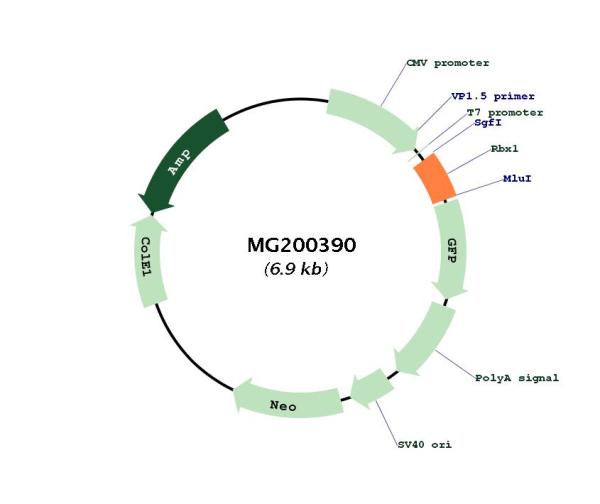Rbx1 (NM_019712) Mouse Tagged ORF Clone
CAT#: MG200390
- TrueORF®
Rbx1 (tGFP-tagged) - Mouse ring-box 1 (Rbx1)
ORF Plasmid: DDK
Lentiviral Particles: DDK w/ Puro mGFP w/ Puro
AAV Particle: DDK
"NM_019712" in other vectors (4)
Specifications
| Product Data | |
| Type | Mouse Tagged ORF Clone |
| Tag | TurboGFP |
| Symbol | Rbx1 |
| Synonyms | 1500002P15Rik; AA517855; ROC1 |
| Vector | pCMV6-AC-GFP |
| E. coli Selection | Ampicillin (100 ug/mL) |
| Mammalian Cell Selection | Neomycin |
| Sequence Data |
>MG200390 representing NM_019712
Red=Cloning site Blue=ORF Green=Tags(s) TTTTGTAATACGACTCACTATAGGGCGGCCGGGAATTCGTCGACTGGATCCGGTACCGAGGAGATCTGCC GCCGCGATCGCC ATGGCGGCGGCGATGGATGTGGATACCCCCAGCGGCACCAACAGCGGCGCGGGCAAGAAGCGCTTTGAAG TTAAAAAGTGGAATGCAGTGGCCCTCTGGGCCTGGGACATTGTGGTTGATAACTGTGCCATCTGCAGGAA CCACATTATGGATCTTTGTATCGAATGTCAGGCCAACCAGGCGTCAGCTACTTCCGAAGAGTGTACGGTT GCATGGGGAGTCTGCAACCATGCTTTTCATTTCCACTGCATCTCTCGATGGCTCAAAACGAGGCAGGTGT GTCCGTTGGACAACAGAGAGTGGGAGTTCCAGAAGTATGGGCAT ACGCGTACGCGGCCGCTCGAG - GFP Tag - GTTTAA >MG200390 representing NM_019712
Red=Cloning site Green=Tags(s) MAAAMDVDTPSGTNSGAGKKRFEVKKWNAVALWAWDIVVDNCAICRNHIMDLCIECQANQASATSEECTV AWGVCNHAFHFHCISRWLKTRQVCPLDNREWEFQKYGH TRTRPLE - GFP Tag - V |
| Restriction Sites |
SgfI-MluI
Cloning Scheme for this gene
Plasmid Map

|
| ACCN | NM_019712 |
| ORF Size | 324 bp |
| OTI Disclaimer | The molecular sequence of this clone aligns with the gene accession number as a point of reference only. However, individual transcript sequences of the same gene can differ through naturally occurring variations (e.g. polymorphisms), each with its own valid existence. This clone is substantially in agreement with the reference, but a complete review of all prevailing variants is recommended prior to use. More info |
| OTI Annotation | This clone was engineered to express the complete ORF with an expression tag. Expression varies depending on the nature of the gene. |
| Product Components | The ORF clone is ion-exchange column purified and shipped in a 2D barcoded Matrix tube containing 10ug of transfection-ready, dried plasmid DNA (reconstitute with 100 ul of water). |
| Reconstitution | 1. Centrifuge at 5,000xg for 5min. 2. Carefully open the tube and add 100ul of sterile water to dissolve the DNA. 3. Close the tube and incubate for 10 minutes at room temperature. 4. Briefly vortex the tube and then do a quick spin (less than 5000xg) to concentrate the liquid at the bottom. 5. Store the suspended plasmid at -20°C. The DNA is stable for at least one year from date of shipping when stored at -20°C. |
| Reference Data | |
| RefSeq | NM_019712.3, NP_062686.1 |
| RefSeq Size | 1655 bp |
| RefSeq ORF | 327 bp |
| Locus ID | 56438 |
| UniProt ID | P62878 |
| Cytogenetics | 15 E1 |
| Gene Summary | E3 ubiquitin ligase component of multiple cullin-RING-based E3 ubiquitin-protein ligase (CRLs) complexes which mediate the ubiquitination and subsequent proteasomal degradation of target proteins, including proteins involved in cell cycle progression, signal transduction, transcription and transcription-coupled nucleotide excision repair (PubMed:22118460). CRLs complexes and ARIH1 collaborate in tandem to mediate ubiquitination of target proteins, ARIH1 mediating addition of the first ubiquitin on CRLs targets (By similarity). The functional specificity of the E3 ubiquitin-protein ligase complexes depends on the variable substrate recognition components (By similarity). As a component of the CSA complex promotes the ubiquitination of ERCC6 resulting in proteasomal degradation (By similarity). Through the RING-type zinc finger, seems to recruit the E2 ubiquitination enzyme, like CDC34, to the complex and brings it into close proximity to the substrate (By similarity). Probably also stimulates CDC34 autoubiquitination (By similarity). May be required for histone H3 and histone H4 ubiquitination in response to ultraviolet and for subsequent DNA repair (By similarity). Promotes the neddylation of CUL1, CUL2, CUL4 and CUL4 via its interaction with UBE2M (By similarity). Involved in the ubiquitination of KEAP1, ENC1 and KLHL41 (By similarity). In concert with ATF2 and CUL3, promotes degradation of KAT5 thereby attenuating its ability to acetylate and activate ATM (By similarity).[UniProtKB/Swiss-Prot Function] |
Documents
| Product Manuals |
| FAQs |
| SDS |
Resources
Other Versions
| SKU | Description | Size | Price |
|---|---|---|---|
| MC204166 | Rbx1 (untagged) - Mouse ring-box 1 (Rbx1), (10ug) |
USD 150.00 |
|
| MR200390 | Rbx1 (Myc-DDK-tagged) - Mouse ring-box 1 (Rbx1) |
USD 150.00 |
|
| MR200390L3 | Lenti ORF clone of Rbx1 (Myc-DDK-tagged) - Mouse ring-box 1 (Rbx1) |
USD 450.00 |
|
| MR200390L4 | Lenti ORF clone of Rbx1 (mGFP-tagged) - Mouse ring-box 1 (Rbx1) |
USD 450.00 |
{0} Product Review(s)
Be the first one to submit a review






























































































































































































































































 Germany
Germany
 Japan
Japan
 United Kingdom
United Kingdom
 China
China

